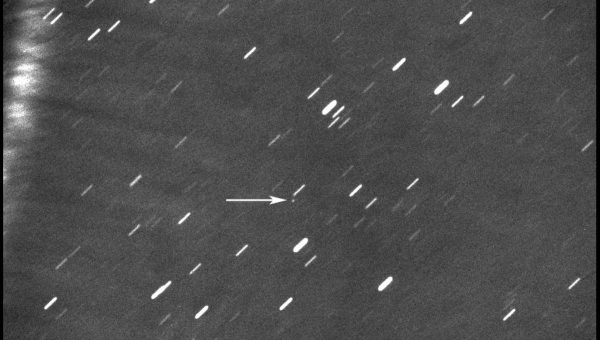Meet 2020 AV2, the first asteroid found that stays inside Venus’s orbit! – SYFY WIRE

An image of the Vatira-class asteroid 2020 AV2 taken by the Virtual Telescope Project on 8 January 2020. Credit: Gianluca Masi
Contributed by
Jan 10, 2020
When you think of asteroids, you probably think of them occupying the vast area of the solar system between the orbits of Mars and Jupiter. There’s a reason we call it , after all.
But asteroids can be pretty much anywhere in the solar system (theoretically, at least). There’s a class of asteroid called (named after the first one confirmed in 2003) that have their orbits entirely inside Earth’s orbit — in other words, the farthest they ever get from the Sun is still closer than the Earth ever gets to the Sun.
Fewer than two dozen are known. That’s because they’re hard to find: They will always appear to be near the Sun in the sky, making the search for them pretty difficult. You can only search for them right after sunset or right before sunrise… and even then you’re looking where the sky is still bright due to twilight, and you’re looking low to the horizon where the line of sight passes through a lot of our atmosphere, blurring the view. That’s why so few have been found so far.
An even more difficult class of asteroid to find would be ones whose orbits are entirely within that of Venus. They’re even closer to the Sun, making them that much harder to spot. Until now, none has even been seen.
But now we have one! On 4 January 2020, the 1.2-meter Oschin Schmidt telescope at the (or ZTF) spotted an asteroid in the twilight. It didn’t take long to determine that it was indeed on an orbit entirely inside that of Venus, making it the very first of its kind ever seen: a Vatira — a slightly tongue-in-cheek of Venus and Atira.
The orbit of the Vatira asteroid 2020 AV2, with its position on 9 January 2020. The bright white part of its orbit is when it’s above the Earth’s orbital plane, and darkened when below. Earth’s orbit is blue. Credit:
The asteroid, initially designated ZTF09k5 and now officially called , has a mildly elliptical orbit that takes it almost as close to the Sun as Mercury and as far as just inside the orbit of Venus, making it a true Vatira. Its orbit is slightly tilted with respect to the overall plane of the solar system, tipped by about 16° from Earth’s orbit. It takes 151 days to orbit the Sun and never gets any closer than about 12 million kilometers from Mercury and 10 million from Venus. to see it at different times and angles.
It’s hard to know just how big it is, because it’s too small to resolve. But based on its distance and brightness (and assuming how reflective it is) it’s likely to be a few kilometers across. It’s possible bigger Vatiras might exist in orbits closer to the Sun, but their increased brightness would be offset by the increased sky brightness, making them harder to find. 2020 AV2 never gets farther than about 40° from the Sun! By coincidence, right now (10 Jan. 2020) Venus is about 40° from the Sun in the western sky after sunset. Take a look and you’ll see why these are so hard to find!
An image of the Vatira-class asteroid 2020 AV2 taken by the Virtual Telescope Project on 8 January 2020. Credit:
But hard doesn’t mean impossible. In fact, 2020 AV2 was found as part of a concerted campaign to use the ZTF to look for Atiras, Vatiras, and what are called co-orbital asteroids (ones sharing Earth or Venus’s orbits). This made me smile: I recently saw talking about the campaign , taking notes to write it up at some point. Now less than a month later comes this announcement (which I also heard about )! So no time like the present to let y’all know about this.

I’ll note that 2020 AV2 is well placed (well, OK-placed) for observing right now, if you have a decent-sized telescope, a good camera, and a lot of experience. The coordinates for your location .
Why is this discovery important? We actually don’t know a whole lot about the environment inside the Earth’s orbit. Again, it’s hard to observe! We’ve sent missions to Mercury and Venus, but they’re not designed to look at huge chunks of the sky and search for tiny blips of light. — a still-theoretical class of asteroids that orbit entirely inside Mercury’s orbit — but nothing has been found yet.
So for one thing that’s a lot of real estate about which we know little. How many asteroids are there? What’s their size distribution? What are their orbits shaped like? Can any hit Venus or Mercury any time soon? Can any be nudged by the inner planets’ gravity into an orbit that gets near us? These are interesting questions!
But they will also tell us about the properties and evolution of the inner solar system as well. Our understanding of the solar system indicates that most of the Atiras and Vatiras probably formed in the main belt and migrated toward the Sun due to various forces acting on them over time. Finding these asteroids then tells us a lot about how the solar system changes over time.
As I was reading Ye’s team’s paper, I had to smile. Why? This comment:
[An asteroid population simulator] predicts 1.2±0.6 Vatiras in the [Zwicky Transient Facility] survey data. Even though none has been actually detected, the model expectation suggests that the first Vatira may soon be found.
Heh. How right they were — the paper was published on 13 December 2019! I’ll note that last year, a near-Vatira was also found by the survey. 2019 AQ3 spends most of its time inside the orbit of Venus, but at its farthest from the Sun just pokes out a little farther than Venus does, so it’s technically an Atira. Interestingly, it’s a near-Venus asteroid, and in the paper they note that interactions with Venus change the orbit of AQ3 a little bit over time, so it may oscillate between being a Vatira and an Atira.
See? We need to know more about this region of space! Lots of weird stuff appears to happen there.
My guess is we will, and soon. Now that we know Vatiras exist, I expect more astronomers will be interested in looking for them. And either way the ZTF is still scanning the twilight sky looking for them as well. If one is there, more are lurking as well, and finding them is just a matter of time. A whole new class of objects, going from theoretical to observed just like that, a whole new region of the solar system opened up for us. What will we find next?








